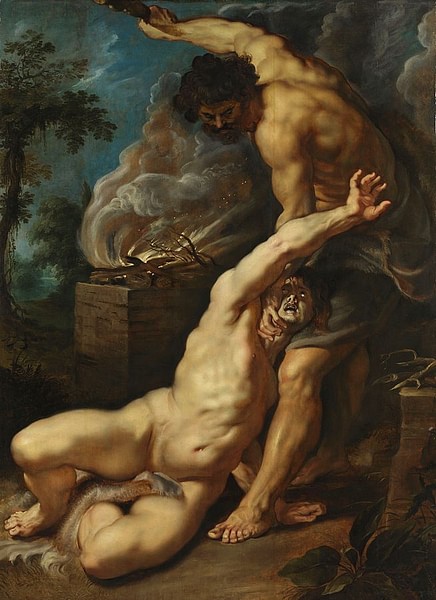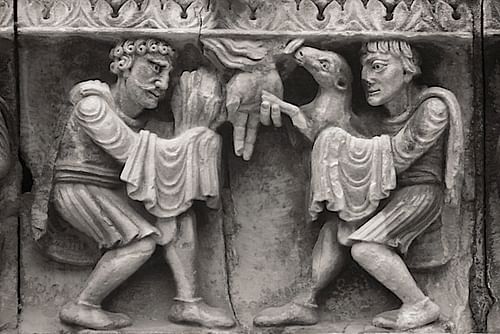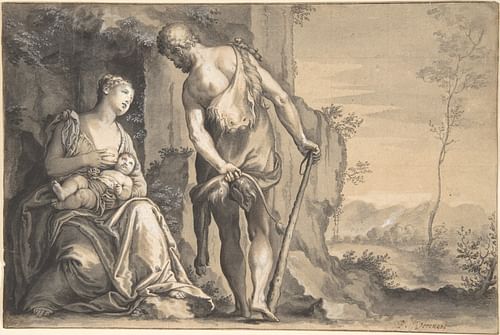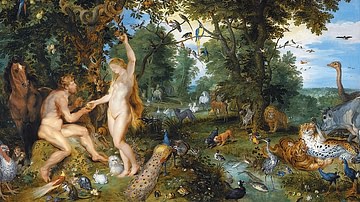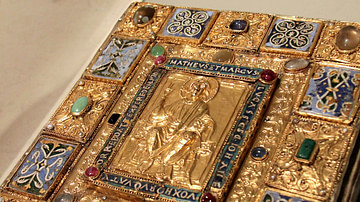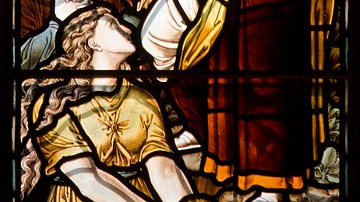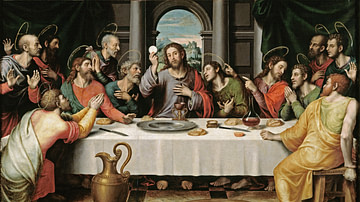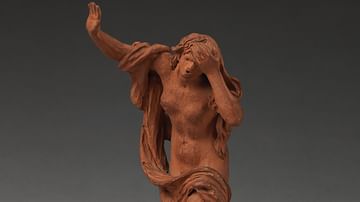Cain and Abel are the first two sons of Adam and Eve after they were expelled from the Garden of Eden in the biblical book of Genesis. According to the biblical story, Cain killed Abel because God accepted Abel's sacrifice but rejected Cain's. With this act of jealousy, Cain became the first murderer.
The Sacrifices of Cain & Abel
Adam made love to his wife Eve, and she became pregnant and gave birth to Cain. She said, "With the help of the Lord I have brought forth a man." Later she gave birth to his brother Abel. Now Abel kept flocks, and Cain worked the soil. In the course of time Cain brought some of the fruits of the soil as an offering to the Lord. And Abel also brought an offering—fat portions from some of the firstborn of his flock. The Lord looked with favor on Abel and his offering, but on Cain and his offering he did not look with favor. (Genesis 4:1-5)
Reading the opening chapters of Genesis can be problematic because the stories were derived from both ancient oral traditions as well as later, edited material over the centuries. Modern biblical scholars continue to attempt to sort out the traditions and sources and try to locate them within their historical contexts. However, as moderns, we are far more interested in the attempt to determine what really happened and try to make logical sense of the details. The ancients did not do this; they knew how to appreciate a story as a story, not letting the facts get in the way.
The problem began when the brothers decided to make sacrifices to God from each of their produce, but God only accepted Abel’s. How did the first two men on earth know to make sacrifices to God? The Law of Moses, which details sacrifices, had not yet been introduced. And even more problematic, why did God reject Cain’s sacrifice? The text provided no reason. However, an ancient Sumerian text described the conflict between nomads and the first settled farmers and may have influenced the story.
The First Murder
So Cain was very angry, and his face was downcast. Then the Lord said to Cain, “Why are you angry? Why is your face downcast? If you do what is right, will you not be accepted? But if you do not do what is right, sin is crouching at your door; it desires to have you, but you must rule over it. Now Cain said to his brother Abel, "Let’s go out to the field." While they were in the field, Cain attacked his brother Abel and killed him. Then the Lord said to Cain, "Where is your brother Abel?" "I don’t know," he replied. "Am I my brother’s keeper?" The Lord said, "What have you done? Listen! Your brother’s blood cries out to me from the ground. Now you are under a curse and driven from the ground, which opened its mouth to receive your brother’s blood from your hand. When you work the ground, it will no longer yield its crops for you. You will be a restless wanderer on the earth." Cain said to the Lord, "My punishment is more than I can bear. Today you are driving me from the land, and I will be hidden from your presence; I will be a restless wanderer on the earth, and whoever finds me will kill me." But the Lord said to him, "Not so; anyone who kills Cain will suffer vengeance seven times over." Then the Lord put a mark on Cain so that no one who found him would kill him. (Genesis 4:5-15)
"Am I my brother’s keeper?" is a rhetorical question where the obvious answer is yes. It is a modern metaphor for the concept that humans should always care for each other. Regarding the "mark upon Cain", there is no clue in the text. Some traditional Christian views connect it to 666, the "number of the beast" in the Book of Revelation (13:18).
Cain in the Land of Nod
So Cain went out from the Lord’s presence and lived in the land of Nod, east of Eden. Cain made love to his wife, and she became pregnant and gave birth to Enoch. Cain was then building a city, and he named it after his son Enoch. (Genesis 4:16-18)
What has always stymied commentators in this passage is when Cain married a woman from the land of Nod. Where did this woman come from? At this point in the narrative, there are only three people on earth—Adam, Eve, and Cain. This is when we need to understand what the writers of this text were concerned to accomplish. The details are problematic for us, but the writers had larger issues to address. In other words, they are considering the bigger picture.
"Be fruitful and multiply" (Genesis 9:1) is the first commandment for humans after their creation by God. But how was this to be achieved? There is only one woman on earth, Eve. Taken literally, to fulfill the commandment, one of Eve’s sons would have to commit incest with their mother. The writers would never permit that; there is no incest in the first family. Hence, they literally created a woman from Nod and inserted it into the narrative to solve the problem.
This is the same rationale for why God rejected Cain’s sacrifice. It does not matter why; in terms of the narrative plot structure, Cain’s murder of his brother spills the first blood on the land and sets the stage for the introduction of evil and corruption of the earth so that God sent the flood.
Genesis 4:17-26 outlines the descendants of Cain. This is when humans develop the arts of civilization in the evolution of cities, music, and metallurgy (coinage and weapons). The violence of Cain is inherited in the next generation. Genesis 5 then does a list of descendants through Adam, highlighting the more noble line, through the birth of their third son, Seth. It concluded with the introduction of Noah, who was deemed righteous in the eyes of God (from the line of Adam).
Cain & Abel in Jewish & Christian Tradition
In their commentaries on the Torah (the books of Moses), the Rabbis taught against the sibling rivalry of all humans (where there are several stories about this in Genesis.) In their interpretation, Abel, as a shepherd, had a better occupation as it provided time and isolation to reflect upon God. They also claimed that Abel was humble before God but Cain lacked this humility. Cain is tied to the theme of exile from the land of Israel, the punishment for sin as emphasized in the books of the Prophets.
In a passage in the gospel of Matthew, Jesus Christ condemned the scribes and Pharisees and predicted the suffering of his followers:
And so upon you will come all the righteous blood that has been shed on earth, from the blood of righteous Abel to the blood of Zechariah son of Berekiah, whom you murdered between the temple and the altar. (23:35).
By the time the gospels were written in the 1st century CE, it was claimed that all the Prophets of Israel had been martyred. In the letter to the Hebrews in the New Testament, Jesus’ sacrifice is compared to Abel’s. The text claimed that Abel and Jesus shared the same concept of faith in God, which Cain apparently lacked (Hebrews 12:24).
Cain & Abel in Islam
In the Quran, the story of Cain and Abel was utilized to teach against murder and its results.
[Prophet], tell them the truth about the story of Adam's two sons: each of them offered a sacrifice, and it was accepted from one and not the other. One said, "I will kill you," but the other said, "God only accepts the sacrifice of those who are mindful of Him. If you raise your hand to kill me, I will not raise mine to kill you. I fear God, the Lord of all worlds, and I would rather you were burdened with my sins as well as yours and became an inhabitant of the Fire: such is the evildoers' reward." But his soul prompted him to kill his brother: he killed him and became one of the losers. God sent a raven to scratch up the ground and show him how to cover his brother's corpse and he said, "Woe is me! Could I not have been like this raven and covered up my brother's body?' He became remorseful." (Sura 5:27-31)
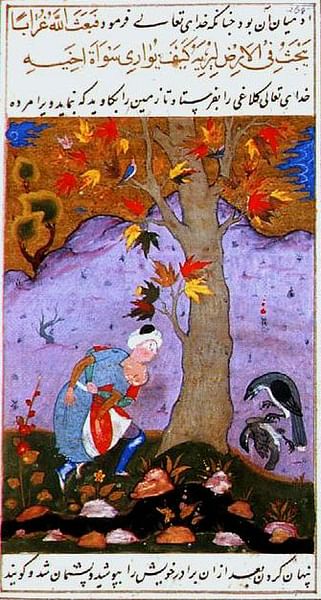
Later traditions in Islam claimed that it was the Devil who motivated Cain and taught him how to kill. Another tradition related that the brothers fought over who would marry a daughter of Adam and Eve.
In Art & Literature
Cain and Abel were portrayed in the works of Titian, Peter Paul Rubens, and William Blake. In William Shakespeare's Hamlet (c. 1600), Claudius and Hamlet represent Cain and Abel, vying for rule. John Steinbeck’s East of Eden (1952) became a blockbuster movie. The novel is set between the American Civil War (1861-1865) and World War I (1914-1918), with two generations of brothers, the second as twins, Aron and Caleb, Cain and Abel respectively.
The story of Cain and Abel continues to be utilized in the exploration of the origins of religious violence. This is particularly germane in the template of sibling rivalry. The model is known as "Blessing Rivalry". If only one son (Cain or Abel, Isaac or Ishmael, Esau or Jacob, or symbolically, Jesus as “the son of God”) can be blessed and given legitimacy, how can the descendants of both live together in full acceptance?
